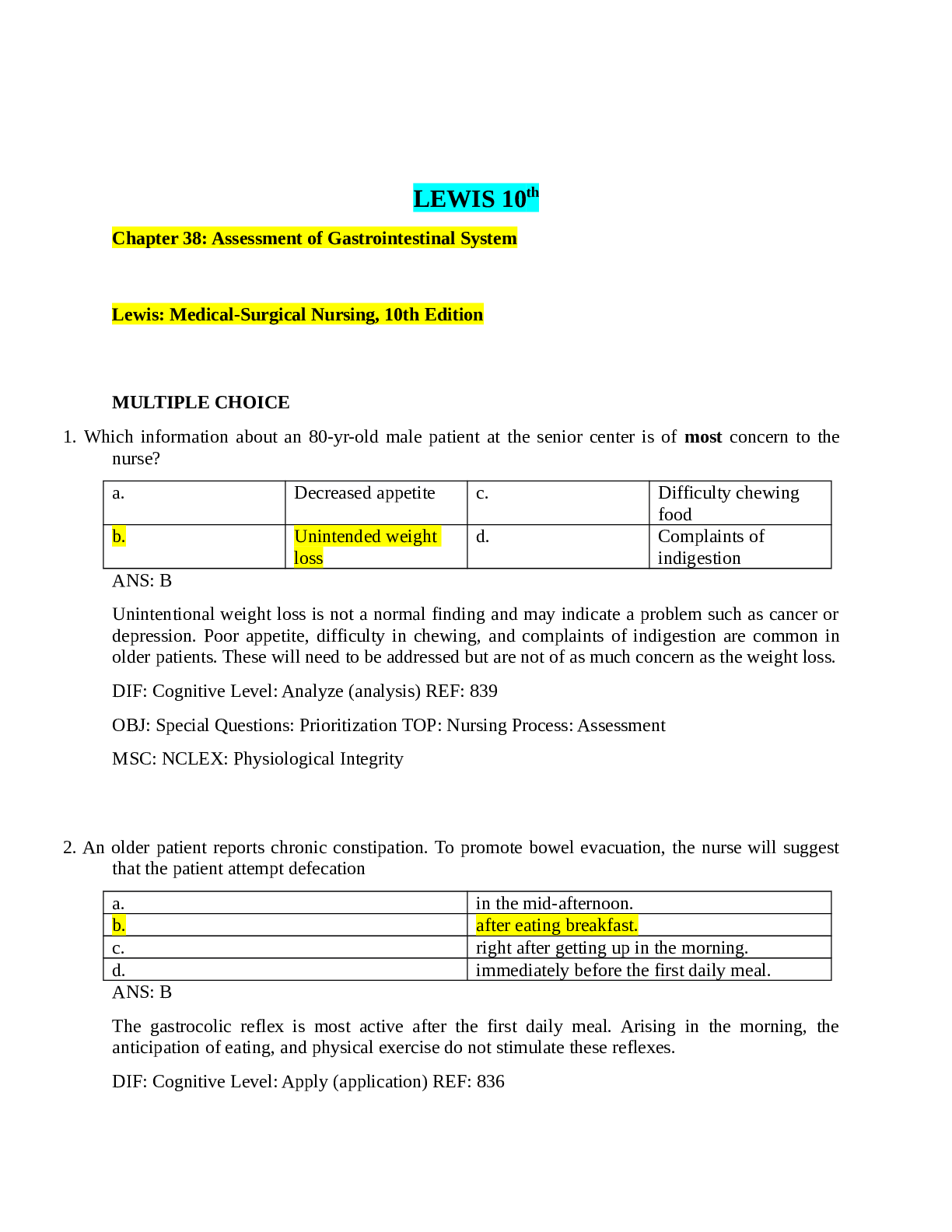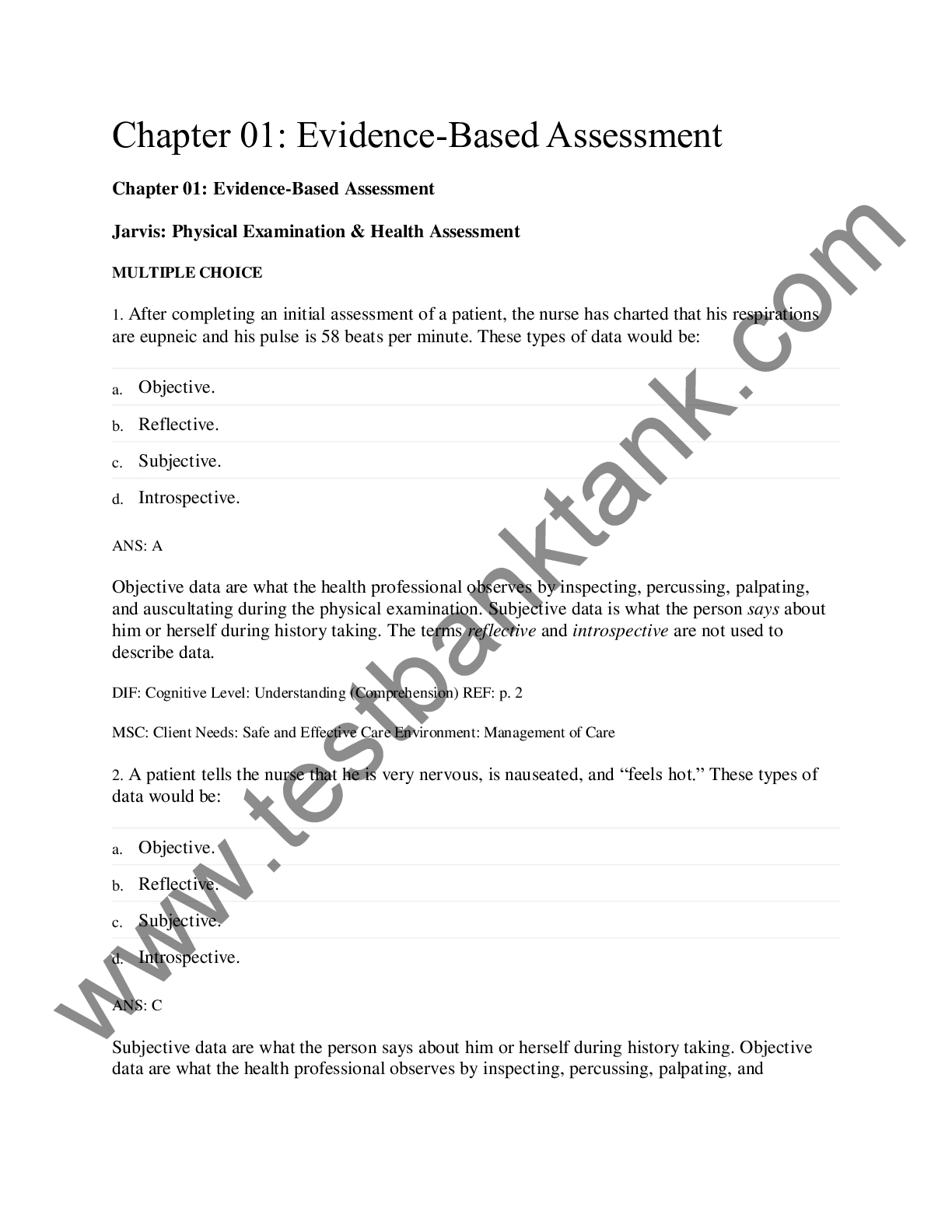*NURSING > TEST BANK > Chapter 6: The Skin, Hair, and Nails ; Bates’ Guide to Physical Examination and History Taking, 12 (All)
Chapter 6: The Skin, Hair, and Nails ; Bates’ Guide to Physical Examination and History Taking, 12th Edition
Document Content and Description Below
Bates’ Guide to Physical Examination and History Taking, 11th Edition Chapter 6: The Skin, Hair, and Nails Multiple Choice 1. A 35-year-old archaeologist comes to your office (located in Phoenix,... Arizona) for a regular skin check-up. She has just returned from her annual dig site in Greece. She has fair skin and reddish-blonde hair. She has a family history of melanoma. She has many freckles scattered across her skin. From this description, which of the following is not a risk factor for melanoma in this patient? A) Age B) Hair color C) Actinic lentigines D) Heavy sun exposure Ans: A Chapter: 06 Page and Header: 165, Health Promotion and Counseling Feedback: The risk for melanoma is increased in people over the age of 50; our patient is 35 years old. The other answers represent known risk factors for melanoma. Especially with a family history of melanoma, she should be instructed to keep her skin covered when in the sun and use strong sunscreen on exposed areas. 2. You are speaking to an 8th grade class about health prevention and are preparing to discuss the ABCDEs of melanoma. Which of the following descriptions correctly defines the ABCDEs? A) A = actinic; B = basal cell; C = color changes, especially blue; D = diameter >6 mm; E = evolution B) A = asymmetry; B = irregular borders; C = color changes, especially blue; D = diameter >6 mm; E = evolution C) A = actinic; B = irregular borders; C = keratoses; D = dystrophic nails; E = evolution D) A = asymmetry; B = regular borders; C = color changes, especially orange; D = diameter >6 mm; E = evolution Ans: B Chapter: 06 This study source was downloaded by 100000831988016 from CourseHero.com on 05-06-2022 10:24:00 GMT -05:00 https://www.coursehero.com/file/18397522/Chapter-6-The-Skin-Hair-and-Nails/ Page and Header: 165, Health Promotion and Counseling Feedback: This is the correct description for the mnemonic. 3. You are beginning the examination of the skin on a 25-year-old teacher. You have previously elicited that she came to the office for evaluation of fatigue, weight gain, and hair loss. You strongly suspect that she has hypothyroidism. What is the expected moisture and texture of the skin of a patient with hypothyroidism? A) Moist and smooth B) Moist and rough C) Dry and smooth D) Dry and rough Ans: D Chapter: 06 Page and Header: 168, Techniques of Examination Feedback: A patient with hypothyroidism is expected to have skin that is dry as well as rough. This is a good example of how the skin can give clues to systemic diseases. 4. A 28-year-old patient comes to the office for evaluation of a rash. At first there was only one large patch, but then more lesions erupted suddenly on the back and torso; the lesions itch. On physical examination, you note that the pattern of eruption is like a Christmas tree and that there are a variety of erythematous papules and macules on the cleavage lines of the back. Based on this description, what is the most likely diagnosis? A) Pityriasis rosea B) Tinea versicolor C) Psoriasis D) Atopic eczema Ans: A Chapter: 06 Page and Header: 176, Table 6–2 Feedback: This is a classic description of pityriasis rosea. The description of a large single or “herald” patch preceding the eruption is a good way to distinguish this rash from other conditions. 5. A 19-year-old construction worker presents for evaluation of a rash. He notes that it started on his back with a multitude of spots and is also on his arms, chest, and neck. It itches a lot. He does This study source was downloaded by 100000831988016 from CourseHero.com on 05-06-2022 10:24:00 GMT -05:00 https://www.coursehero.com/file/18397522/Chapter-6-The-Skin-Hair-and-Nails/ sweat more than before because being outdoors is part of his job. On physical examination, you note dark tan patches with a reddish cast that has sharp borders and fine scales, scattered more prominently around the upper back, chest, neck, and upper arms as well as under the arms. Based on this description, what is your most likely diagnosis? A) Pityriasis rosea B) Tinea versicolor C) Psoriasis D) Atopic eczema Ans: B Chapter: 06 Page and Header: 176, Table 6–2 Feedback: This is a typical description of tinea versicolor. The information that the patient is sweating more also helps support this diagnosis, because tinea is a fungal infection and is promoted by moisture. 6. A 68-year-old retired farmer comes to your office for evaluation of a skin lesion. On the right temporal area of the forehead, you see a flattened papule the same color as his skin, covered by a dry scale that is round and feels hard. He has several more of these scattered on the forehead, arms, and legs. Based on this description, what is your most likely diagnosis? A) Actinic keratosis B) Seborrheic keratosis C) Basal cell carcinoma D) Squamous cell carcinoma Ans: A Chapter: 06 Page and Header: 185, Table 6–9 Feedback: This is a typical description of actinic keratosis. Actinic keratosis may be easier to feel than to see. If left untreated, approximately 1% of cases can develop into squamous cell carcinoma. 7. A 58-year-old gardener comes to your office for evaluation of a new lesion on her upper chest. The lesion appears to be “stuck on” and is oval, brown, and slightly elevated with a flat surface. It has a rough, wartlike texture on palpation. Based on this description, what is your most likely diagnosis? A) Actinic keratosis B) Seborrheic keratosis C) Basal cell carcinoma D) Squamous cell carcinoma This study source was downloaded by 100000831988016 from CourseHero.com on 05-06-2022 10:24:00 GMT -05:00 https://www.coursehero.com/file/18397522/Chapter-6-The-Skin-Hair-and-Nails/ Ans: B Chapter: 06 Page and Header: 185, Table 6–9 Feedback: This is a typical description for seborrheic keratosis. The “stuck on” appearance and the rough, wartlike texture are key features for the diagnosis. They often produce a greasy scale when scratched with a fingernail, which further helps to distinguish them from other lesions. Frequently, these benign lesions actually meet several of the ABCDEs of melanoma, so it is important to distinguish these lesions to prevent unnecessary biopsy. It is important to consider biopsy whenever there is any doubt, though. 8. A 72-year-old teacher comes to a skilled nursing facility for rehabilitation after being in the hospital for 6 weeks. She was treated for sepsis and respiratory failure and had to be on the ventilator for 3 weeks. You are completing your initial assessment and are evaluating her skin condition. On her sacrum there is full-thickness skin loss that is 5 cm in diameter, with damage to the subcutaneous tissue. The underlying muscle is not affected. You diagnose this as a pressure ulcer. What is the stage of this ulcer? A) Stage 1 B) Stage 2 C) Stage 3 D) Stage 4 Ans: C Chapter: 06 Page and Header: 191, Table 6–13 Feedback: A stage 3 ulcer is a full-thickn [Show More]
Last updated: 2 years ago
Preview 1 out of 9 pages
.png)
Buy this document to get the full access instantly
Instant Download Access after purchase
Buy NowInstant download
We Accept:

Reviews( 0 )
$11.00
Can't find what you want? Try our AI powered Search
Document information
Connected school, study & course
About the document
Uploaded On
May 06, 2022
Number of pages
9
Written in
Additional information
This document has been written for:
Uploaded
May 06, 2022
Downloads
0
Views
167



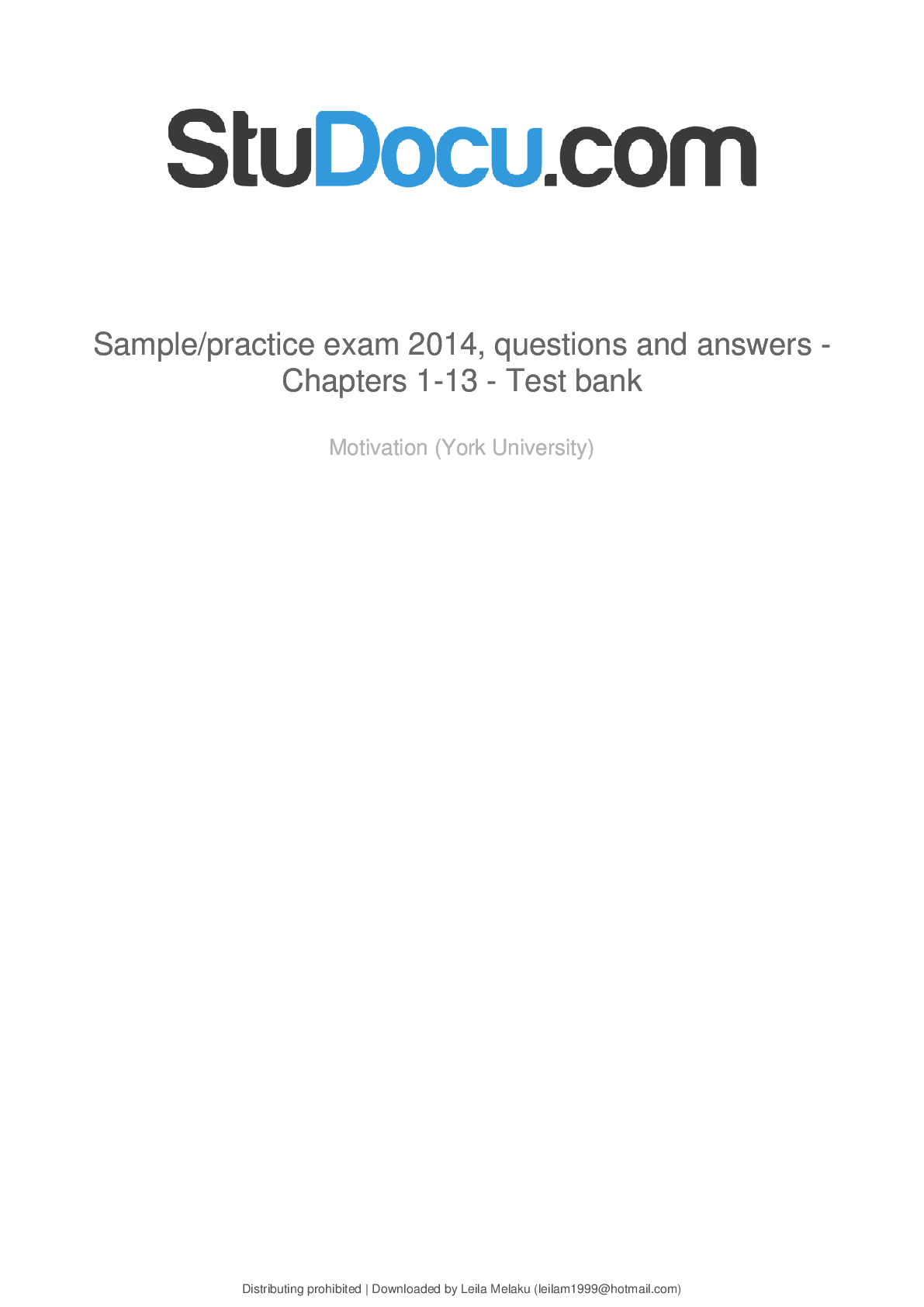
.png)

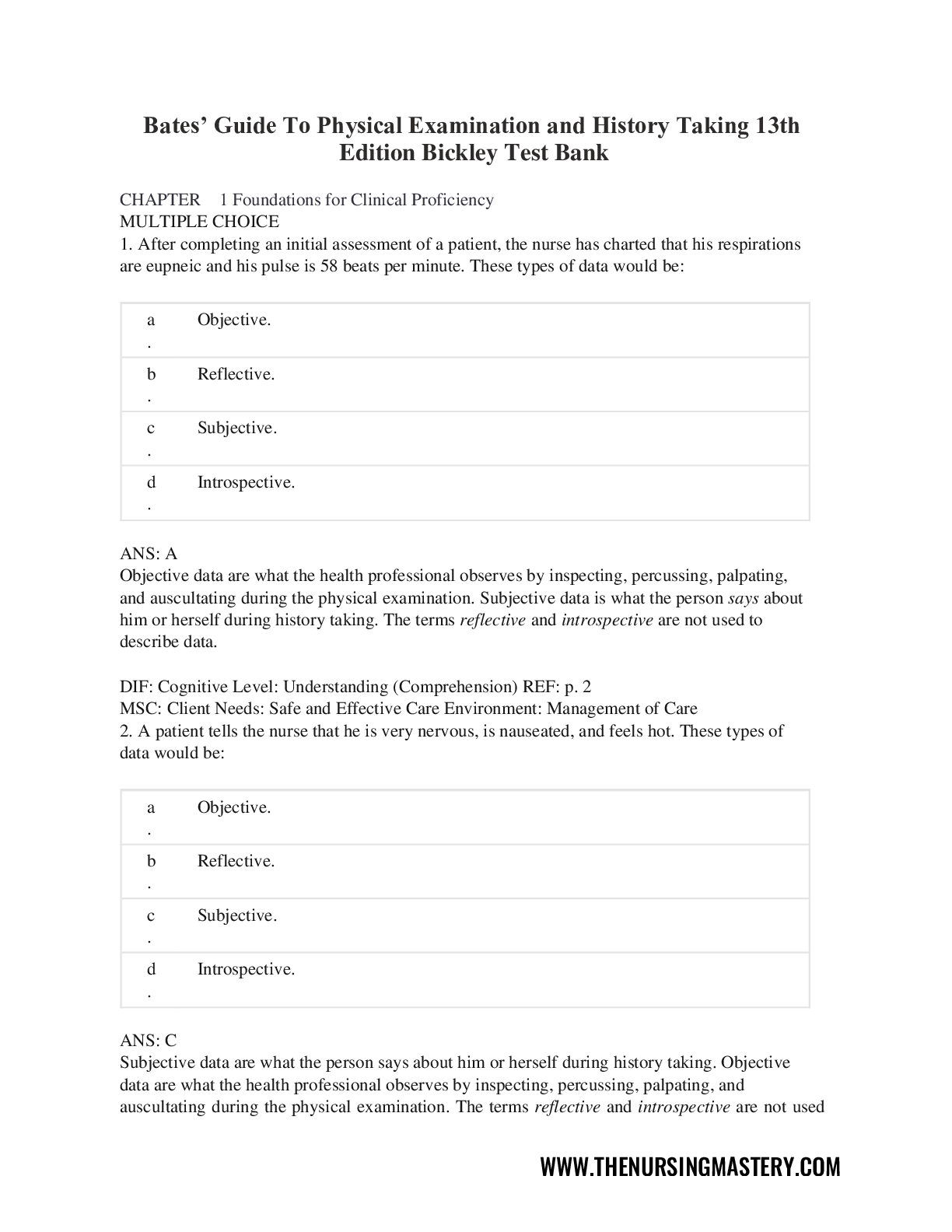

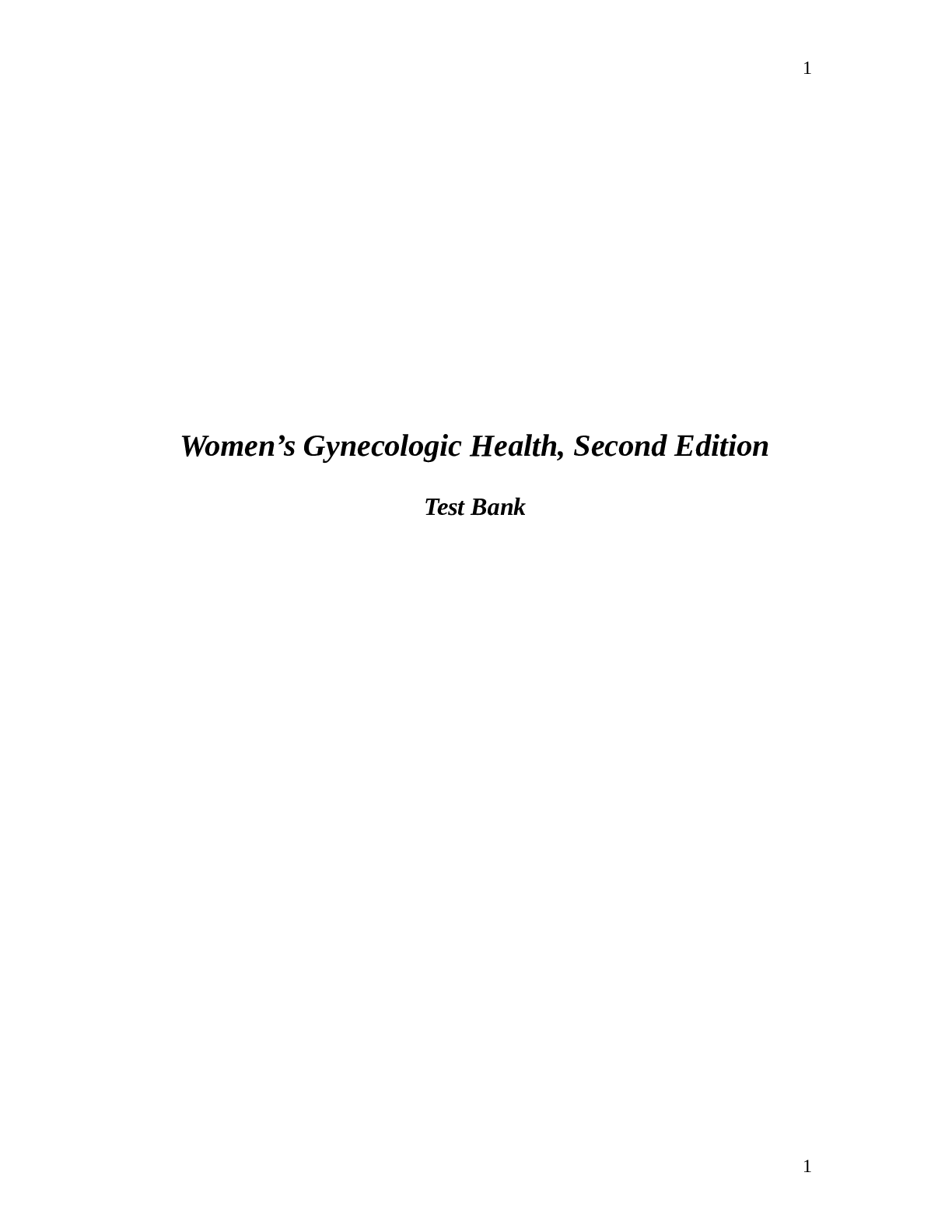


.png)
